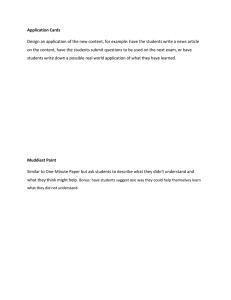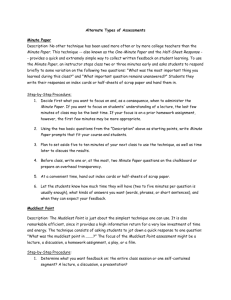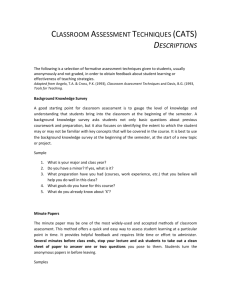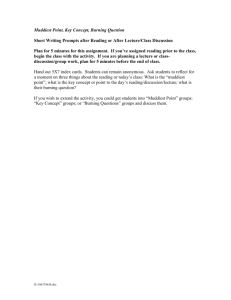Minute Paper
advertisement
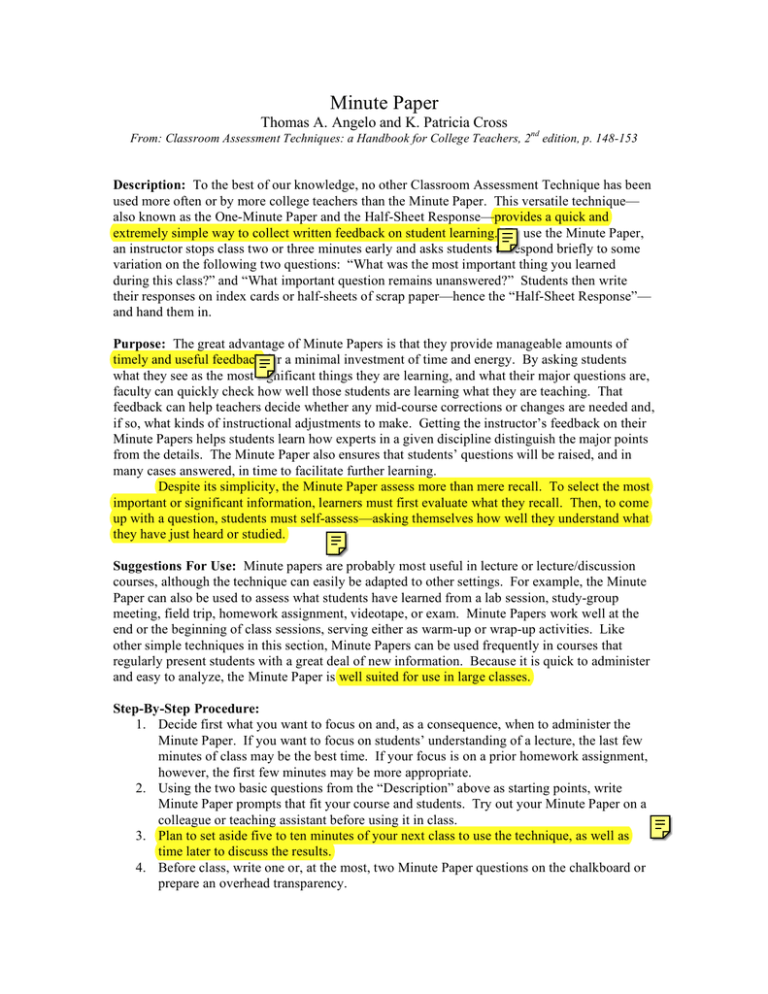
Minute Paper Thomas A. Angelo and K. Patricia Cross From: Classroom Assessment Techniques: a Handbook for College Teachers, 2nd edition, p. 148-153 Description: To the best of our knowledge, no other Classroom Assessment Technique has been used more often or by more college teachers than the Minute Paper. This versatile technique— also known as the One-Minute Paper and the Half-Sheet Response—provides a quick and extremely simple way to collect written feedback on student learning. To use the Minute Paper, an instructor stops class two or three minutes early and asks students to respond briefly to some variation on the following two questions: “What was the most important thing you learned during this class?” and “What important question remains unanswered?” Students then write their responses on index cards or half-sheets of scrap paper—hence the “Half-Sheet Response”— and hand them in. Purpose: The great advantage of Minute Papers is that they provide manageable amounts of timely and useful feedback for a minimal investment of time and energy. By asking students what they see as the most significant things they are learning, and what their major questions are, faculty can quickly check how well those students are learning what they are teaching. That feedback can help teachers decide whether any mid-course corrections or changes are needed and, if so, what kinds of instructional adjustments to make. Getting the instructor’s feedback on their Minute Papers helps students learn how experts in a given discipline distinguish the major points from the details. The Minute Paper also ensures that students’ questions will be raised, and in many cases answered, in time to facilitate further learning. Despite its simplicity, the Minute Paper assess more than mere recall. To select the most important or significant information, learners must first evaluate what they recall. Then, to come up with a question, students must self-assess—asking themselves how well they understand what they have just heard or studied. Suggestions For Use: Minute papers are probably most useful in lecture or lecture/discussion courses, although the technique can easily be adapted to other settings. For example, the Minute Paper can also be used to assess what students have learned from a lab session, study-group meeting, field trip, homework assignment, videotape, or exam. Minute Papers work well at the end or the beginning of class sessions, serving either as warm-up or wrap-up activities. Like other simple techniques in this section, Minute Papers can be used frequently in courses that regularly present students with a great deal of new information. Because it is quick to administer and easy to analyze, the Minute Paper is well suited for use in large classes. Step-By-Step Procedure: 1. Decide first what you want to focus on and, as a consequence, when to administer the Minute Paper. If you want to focus on students’ understanding of a lecture, the last few minutes of class may be the best time. If your focus is on a prior homework assignment, however, the first few minutes may be more appropriate. 2. Using the two basic questions from the “Description” above as starting points, write Minute Paper prompts that fit your course and students. Try out your Minute Paper on a colleague or teaching assistant before using it in class. 3. Plan to set aside five to ten minutes of your next class to use the technique, as well as time later to discuss the results. 4. Before class, write one or, at the most, two Minute Paper questions on the chalkboard or prepare an overhead transparency. 5. At a convenient time, hand out index cards or half-sheets of scrap paper. 6. Unless there is a very good reason to know who wrote what, direct students to leave their names off the papers or cards. 7. Let the students know how much time they will have (two to five minutes per question is usually enough), what kinds of answers you want (words, phrases, or short sentences), and when they can expect your feedback. Turning The Data You Collect Into Useful Information: Simply tabulating the responses and making note of any useful comments is often all the analysis needed. Consider saving Minute Papers from early in the term to compare with responses at midterm and later. Comparing responses over time can allow to see changes and developments in the clarity of student writing and thoughtfulness of answers. Ideas For Adapting And Extending This CAT: Use only half of the Minute Paper. That is, ask students either for the most important points(s) or for their question(s). These “Half-Minute Papers” are the most common adaptations because they make the assessment process even simpler and quicker. The Muddiest Point is a particularly creative example of such an adaptation (note from MMS: The Muddiest Point CAT asks students to write a response to the question “What was the muddiest point in __________?” where the focus of the assessment might be a lecture, discussion, homework assignment, lab, etc…) Change the wording to make the prompt more appropriate and specific. For example, instead of asking students to identify the most significant point, ask them for one of the following: the most illuminating example, the most powerful image, the most convincing argument or counterargument, the most surprising information, the most memorable character, or the most disturbing idea. Allow students a few extra minutes to compare and discuss their Minute Paper responses with their classmates in pairs or small groups. Assign students to small groups. Give each group, in turn the opportunity to suggest questions for the Minute Papers and let the members of the group analyze and present the results to the whole class. Pros: Minute Papers provide immediate mid-course feedback to teachers and allow quick response to students. This advantage is especially important in college classrooms, where many issues and questions have limited life spans and time is always in short supply. The responses—even from a very large class—can be read, tabulated, and analyzed quickly and with limited effort. Faculty using the Minute Paper demonstrate respect for and interest in student feedback, thereby encouraging active listening and engagement, which are often lacking in large classes. Feedback on the Minute Paper allows individual students to compare their responses with those of the class as a whole. Cons: If Minute Papers are overused or poorly used, students will begin to view the technique as a gimmick or a pro forma exercise in polling It is more difficult than it may seem to prepare questions that can be immediately and clearly comprehended and quickly answered. Caveats: Not all learning experiences can be meaningfully assessed by an instrument that asks learners to note significant points or remaining questions. In other words, this technique is flexible but not universally applicable. When students seem to confuse trivial details with significant themes, or pose questions that you have already answered several times, remind yourself that they see the material through different eyes, hear it with different ears, and make sense of it differently than you do. Hold off responding until the irritation has faded. Accepting their starting points is often a necessary step in getting them to the desired learning goal. Responding to Minute Papers often takes longer than planned, because questions lead to further questions. Build in some flexibility but set clear limits for the time you will spend on feedback. To temper expectations and prevent individual disappointment, let the class know in advance that you may not be able to comment on every important point and question submitted. It is often wise to promise less feedback than you think you can deliver. Let students know in advance, for example, that you will respond to the three most commonly raised points and questions from their Minute Papers, even though you hope to do more. References and Resources: Wilson (1986) describes the Minute Paper in an article on using feedback from students and consultants to improve college teaching. The term half-sheet response comes from an article on a similar technique by Weaver and Cottrell (1985). Of course, versions of the Minute Paper and many other CATs, probably have been invented and reinvented time and again by instructors in various colleges at different times. Wilson, R.C. (1986) Improving Faculty Teaching: Effective Use of Student Evaluations and Consultants, Journal of Higher Education, v. 57(2), p. 196-211. Weaver, R.L. and Cotrell, H.W. (1985) Mental Aerobics: The Half-Sheet Response, Innovative Higher Education, v. 10, p. 23-31.
